Staying Fit


With the end of the end of national coronavirus public health emergency on May 11, many workplaces and offices are reopening fully — meaning more employees who have been working remotely are being called back to their buildings.
It's a transition that experts say can bring up feelings of stress and trepidation for those who have been working from home, many of whom say they'd be interested in continuing to work remotely even after the pandemic subsides, according to a recent survey by YouGov.


AARP Membership— $12 for your first year when you sign up for Automatic Renewal
Get instant access to members-only products and hundreds of discounts, a free second membership, and a subscription to AARP the Magazine.
If you're anxious about the return to the office, consider these 5 strategies to ease the transition to in-person work.
Hold a dress rehearsal
Rehearsing your daily routine is one way to combat first-day jitters, says Connecticut-based clinical psychologist Holly Schiff.
Schiff advises worried clients to plan a “dry run” of their workday: Choose a day to wake up, eat breakfast, get dressed and commute like you normally would.
This not only gives you the chance to sort out any hitches — for example, has the bus schedule changed since last year? Did you remember to bring your office key card? — but also prepares you physically and mentally for what your new routine will feel like.
Streamline routines and practice self-care
Returning to the office doesn't just mean a change to your workday, but to household routines like childcare arrangements or your sleep schedule that may have shifted during the pandemic.
"Do your best in your home environment to simplify,” says Annie McKee, a senior fellow at the University of Pennsylvania Graduate School of Education and the author of How to Be Happy at Work. “If your kids were involved in 10 activities prior to the pandemic, maybe seven will do now. If you're the one who does the grocery shopping, keep using [a delivery service]."




































































More From AARP
Still Working After Age 70? You’re Not Alone
Many older adults opt to build retirement savings while enjoying their jobs
10 Job Resolutions to Make in 2023
Building skills and taking vacation time can boost your career in the new year
10 Ways to Deal With Distractions in the Office
Tips for handling interruptions you don’t have working from home